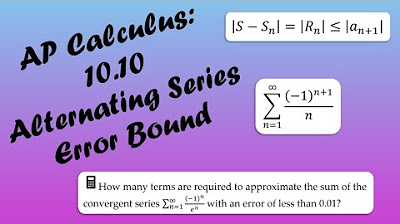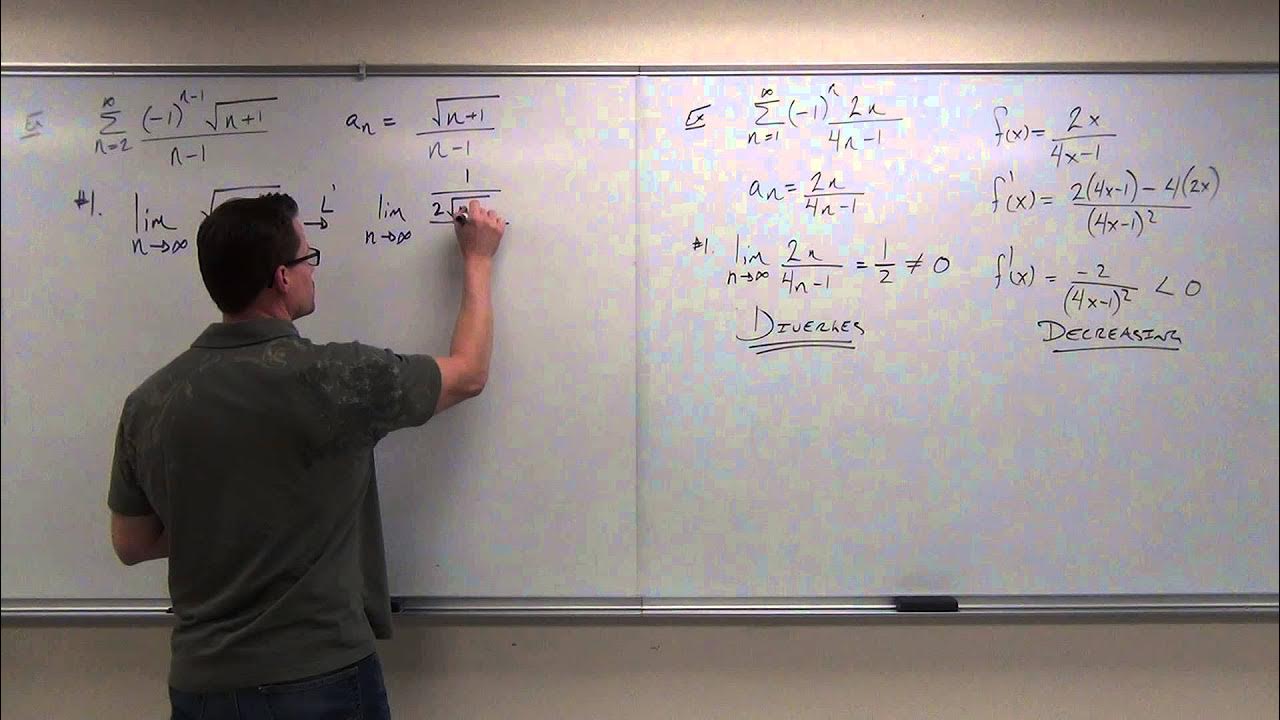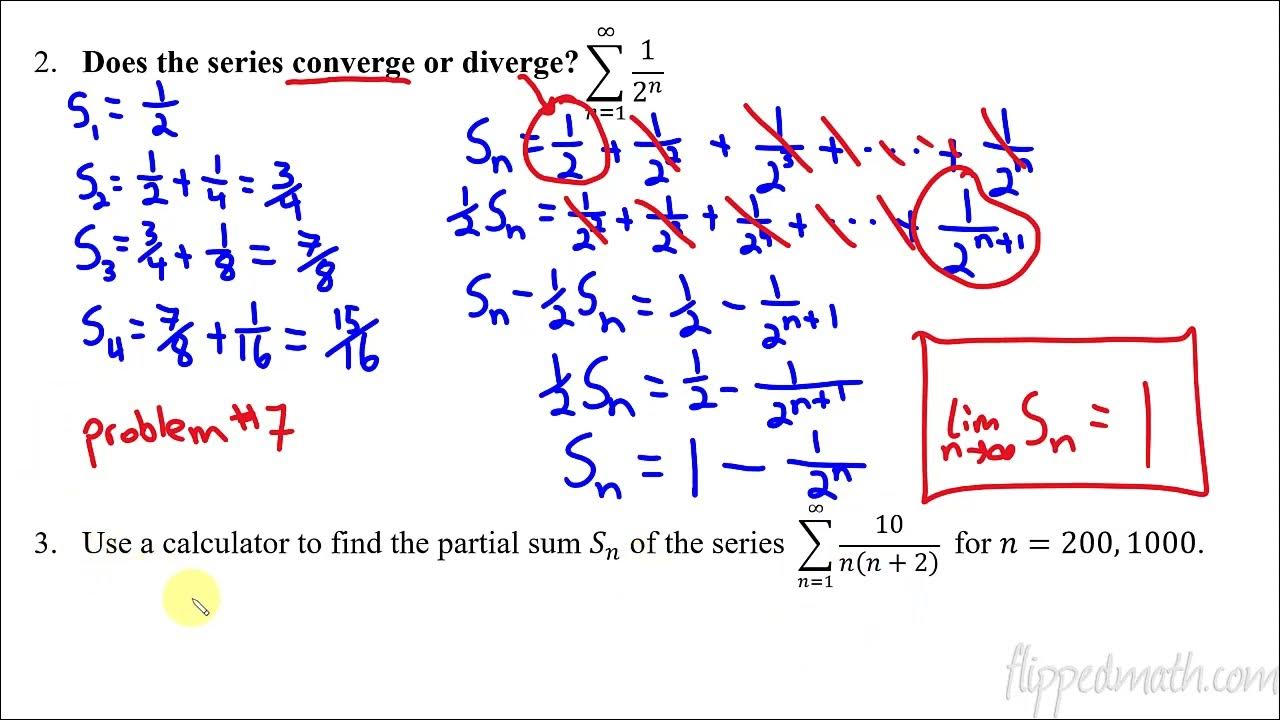Calculus BC – 10.10 Alternating Series Error Bound
TLDRIn this engaging calculus lesson, Mr. Bean explores the concept of error bounds in alternating series. He begins by explaining the fundamentals of alternating series and their convergence, using the alternating harmonic series as an example. Mr. Bean guides students through calculating terms and partial sums, and then转换 their values to decimals for further analysis. He emphasizes the importance of understanding the relationship between the partial sums and the actual sum of an infinite series, as this is key to determining error bounds. The lesson also includes practical exercises, such as graphing points and approximating series sums, to help students grasp the concept more concretely. Mr. Bean concludes by highlighting the relevance of alternating series and error bounds in calculus exams, encouraging students to master these techniques for better performance.
Takeaways
- 📚 Alternating series must converge to have an error bound; non-convergent series do not apply.
- 📈 The error bound helps to determine the maximum possible error in approximating the sum of an infinite series with a finite number of terms.
- 🔢 Error bounds are calculated using the absolute value of the next term in the series after the last term included in the partial sum.
- 📊 The alternating harmonic series is used as an example to illustrate the concept of error bounds and its calculation.
- 📝 The process of finding error bounds involves creating a table of terms and partial sums, then converting these to decimals for easier computation.
- 📊 Graphing the partial sums and the actual sum (when known) can visually demonstrate the convergence and error bounds of an alternating series.
- 🌐 The sum of an infinite alternating harmonic series equals the natural log of 2, which is approximately 0.6931.
- 🔢 The error for each term can be calculated by subtracting the partial sum from the actual sum of the series (when known).
- 📈 The pattern of partial sums often shows a bouncing effect around the line representing the actual sum of the series.
- 📝 The error bound is a useful concept in calculus, particularly in the context of approximating sums and understanding the behavior of series.
- 🎓 Understanding and applying error bounds is a common topic in calculus exams, such as the AP Calculus BC free response section.
Q & A
What is the main topic of this calculus lesson?
-The main topic of this lesson is the concept of error bounds in the context of alternating series.
What is a precondition for discussing error bounds in alternating series?
-The alternating series must be converging. Error bounds cannot be determined for non-converging series.
How does Mr. Bean introduce the concept of alternating series?
-Mr. Bean introduces the concept by discussing the alternating harmonic series and filling out a chart to illustrate how the series progresses.
What is the significance of converting fractions to decimals in this lesson?
-Converting fractions to decimals helps in plotting the partial sums and understanding the behavior of the alternating series as it approaches its limit.
What is the sum of the infinite alternating harmonic series as mentioned in the transcript?
-The sum of the infinite alternating harmonic series is equal to the natural logarithm of two, approximately 0.6931.
How does the error bound relate to the terms of the alternating series?
-The error bound is the absolute value of the next term in the series. It provides a boundary on how far off the partial sum can be from the actual sum of the series.
What is the practical application of understanding error bounds in calculus?
-Understanding error bounds is crucial for approximating the sum of infinite series and ensuring the accuracy of these approximations, which is often required in various calculus problems and real-world applications.
How does Mr. Bean demonstrate the application of error bounds in the lesson?
-Mr. Bean demonstrates the application by walking through the process of calculating error bounds for given series and interpreting their significance in approximating the sum of the series.
What is the importance of alternating series and error bounds in the context of the calculus BC free response section?
-Alternating series and error bounds often appear in the calculus BC free response section of exams. Understanding these concepts can lead to easy points on the test and is a common topic across multiple years of exams.
What is the final problem presented in the transcript, and how does it relate to the concept of error bounds?
-The final problem involves showing that a certain approximation of a function f(x) at x=1 has an error less than 0.01 using the concept of error bounds and the first few terms of the series representation of f(x).
How does Mr. Bean emphasize the importance of understanding alternating series and error bounds?
-Mr. Bean emphasizes the importance by noting their frequent appearance in calculus exams, providing practical examples of their application, and demonstrating how they can be used to solve problems and approximate values with a high degree of accuracy.
Outlines
📚 Introduction to Error Bounds in Alternating Series
This paragraph introduces the concept of error bounds in the context of alternating series. Mr. Bean explains that to understand error bounds, one must first understand alternating series and their convergence. He emphasizes that error bounds are only applicable to converging series. The paragraph begins with an activity where viewers are encouraged to calculate the terms and partial sums of an alternating harmonic series, converting fractions to decimals and plotting these values on a graph. The ultimate goal is to demonstrate how the partial sums of an alternating series approach the actual sum of the series, which for the given harmonic series is the natural log of two.
📈 Graphing and Understanding Alternating Series
In this paragraph, Mr. Bean continues the discussion on alternating series by focusing on graphing. He explains how to plot the points for the partial sums of the series and how these points relate to the actual sum of the series. The graph illustrates the oscillation of the partial sums around the line representing the sum of the infinite series. Mr. Bean then introduces the concept of error, which is the difference between the actual sum and the partial sum at any given term. He explains how the error decreases as more terms are added to the series, and how this can be quantified by subtracting the partial sum from the actual sum of the series.
🔢 Calculating Error Bounds for Alternating Series
This paragraph delves into the mathematical process of calculating error bounds for alternating series. Mr. Bean explains that the error bound is the absolute value of the next term in the series, which sets a limit on how far the partial sum can deviate from the actual sum of the series. He provides a step-by-step example of how to calculate the error bound for a given series, emphasizing that the error must be less than or equal to the absolute value of the next term. This concept is crucial for approximating the sum of an infinite series and understanding the precision of this approximation.
📊 Approximating Sums with Error Bounds
Mr. Bean continues the lesson by demonstrating how to use error bounds to approximate the sum of an infinite series. He provides an example where the error bound is set to be less than a specific value, and shows how to calculate the number of terms needed to achieve this level of accuracy. The paragraph also includes a practical example of using a calculator to sum the first few terms of a series and using the resulting partial sum to estimate the sum of the entire series. The key takeaway is that by understanding the error bound, one can determine the precision of the approximation and how many terms are necessary to reach a desired level of accuracy.
🎓 The Importance of Alternating Series and Error Bounds in Calculus
In the final paragraph, Mr. Bean wraps up the lesson by highlighting the significance of alternating series and error bounds in calculus. He mentions that these concepts frequently appear in free-response questions on the calculus BC exam, making them an important topic for students to master. The paragraph concludes with a challenging problem that applies the concepts learned throughout the lesson, reinforcing the idea that understanding error bounds can lead to accurate approximations of complex functions. Mr. Bean encourages viewers to practice these concepts to gain a deeper understanding and prepare for potential exam questions.
Mindmap
Keywords
💡Alternating Series
💡Error Bound
💡Convergence
💡Partial Sum
💡Natural Logarithm
💡Graphing
💡Decimals
💡Approximation
💡Remainder
💡Absolute Value
Highlights
Introduction to the concept of error bounds in the context of alternating series.
Explanation that error bounds make more sense when understood in the context of what alternating series do.
Requirement for the alternating series to converge in order to find an error bound.
Discussion of the alternating harmonic series and its convergence.
Activity suggestion for filling out a chart to understand the alternating series better.
Step-by-step guide on how to calculate the terms and partial sums of an alternating series.
Conversion of fractions to decimals for better understanding of the series pattern.
Explanation of how to graph the partial sums and terms of an alternating series.
Revelation that the sum of an infinite alternating harmonic series equals the natural log of two.
Illustration of how the alternating series oscillates around the line representing the sum of the infinite series.
Definition and calculation of the error and remainder in the context of an alternating series.
Explanation that the error must be less than or equal to the absolute value of the next term in the series.
Introduction to the alternating series error bound and its significance in approximating the sum of a series.
Practice problem involving the calculation of error bounds for a given series.
Discussion on the importance of understanding alternating series and error bounds for calculus exams.
Final problem showing how to approximate a function with an error less than a specified value using the concept of error bounds.
Emphasis on the practical application of alternating series and error bounds in free response questions on the calculus exam.
Transcripts
Browse More Related Video

AP Calculus BC Lesson 10.10

Calculus BC – 10.7 Alternating Series Test for Convergence

Alternating Series Day 2

Calculus 2 Lecture 9.5: Showing Convergence With the Alternating Series Test, Finding Error of Sums

Alternating series remainder | Series | AP Calculus BC | Khan Academy

Calculus BC – 10.1 Defining Convergent and Divergent Infinite Series
5.0 / 5 (0 votes)
Thanks for rating: